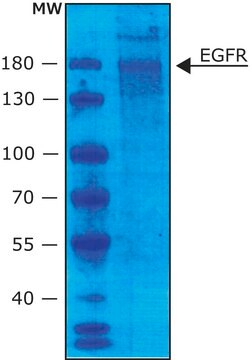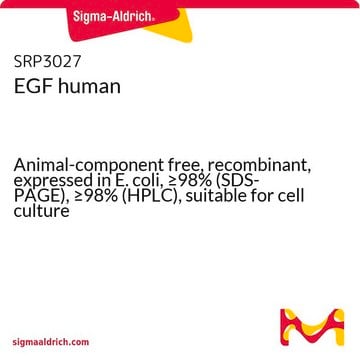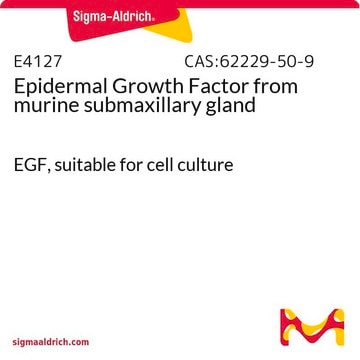E2645
Epidermal Growth Factor Receptor human
lyophilized powder, ≥15,000 units/mg protein (Bradford)
Synonym(e):
ERBB, ErbB1, HER1, EGFR
About This Item
Empfohlene Produkte
Biologische Quelle
human
Qualitätsniveau
Form
lyophilized powder
Wirksamkeit
>15000.00 units/mg
Spezifische Aktivität
≥15,000 units/mg protein (Bradford)
Mol-Gew.
~170 kDa
Verpackung
pkg of 500UN
Lagerbedingungen
avoid repeated freeze/thaw cycles
Methode(n)
cell based assay: suitable
Farbe
white
Löslichkeit
glycerol: 10%, clear to slightly hazy, colorless
UniProt-Hinterlegungsnummer
Versandbedingung
dry ice
Lagertemp.
−20°C
Angaben zum Gen
human ... EGFR(1956)
Suchen Sie nach ähnlichen Produkten? Aufrufen Leitfaden zum Produktvergleich
Allgemeine Beschreibung
Epidermal growth factor receptor (EGFR) belongs to a family of cell surface receptors called receptor tyrosine kinases (RTKs) and is also the most studied member of this family. The EGFR is encoded by the ErbB gene, mapped to chromosome 7 q22. These receptors are attached to the cytoplasmic membrane and consist of an ectodomain (ECD), comprising of four subdomains called DI-DIV, a hydrophobic transmembrane domain, and an intracytoplasmic tyrosine kinase domain.
Biochem./physiol. Wirkung
Einheitendefinition
Physikalische Form
Angaben zur Herstellung
Ähnliches Produkt
Lagerklassenschlüssel
11 - Combustible Solids
WGK
WGK 3
Flammpunkt (°F)
Not applicable
Flammpunkt (°C)
Not applicable
Analysenzertifikate (COA)
Suchen Sie nach Analysenzertifikate (COA), indem Sie die Lot-/Chargennummer des Produkts eingeben. Lot- und Chargennummern sind auf dem Produktetikett hinter den Wörtern ‘Lot’ oder ‘Batch’ (Lot oder Charge) zu finden.
Besitzen Sie dieses Produkt bereits?
In der Dokumentenbibliothek finden Sie die Dokumentation zu den Produkten, die Sie kürzlich erworben haben.
Kunden haben sich ebenfalls angesehen
Unser Team von Wissenschaftlern verfügt über Erfahrung in allen Forschungsbereichen einschließlich Life Science, Materialwissenschaften, chemischer Synthese, Chromatographie, Analytik und vielen mehr..
Setzen Sie sich mit dem technischen Dienst in Verbindung.








